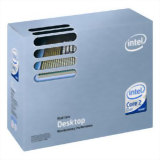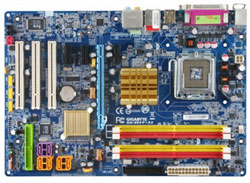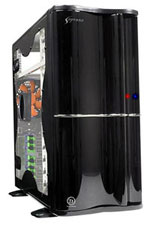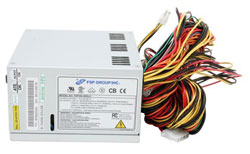Upgraded Intel Midrange Platform
If we had to choose one system as an overall recommendation today, it would have to be this upgraded Core 2 Duo configuration. There are almost no compromises made, and without spending significantly more money it will be difficult to improve performance. As usual, the one exception is gaming, where a faster, more expensive GPU is almost always a possibility. Below is our upgraded Intel recommendation.
 |
As with the AMD platform, our upgraded Intel system has moved up one rung on the performance ladder. Moving from the E6300 to the E6400 represents a 14% CPU speed increase, and it comes with a 23% price increase. Bang for the buck is actually better than the AMD upgrade, but there are other advantages as well. The base clock speed is now 2.13 GHz with an 8X multiplier. Clock speeds of beyond 3 GHz should now be achievable, with a 400 MHz front side bus equating to a 3.2 GHz CPU. Even without overclocking, the E6400 is no slouch, generally offering performance that falls somewhere between that of the Athlon X2 4600+ and 5000+. With overclocking, the E6400 at 3.0 GHz appears to be out of reach of anything AMD can offer with their current architecture and process technology, all at a price of about $225.
You could upgrade to 4MB of cache and 2.4 GHz for another $90 if you so desire, and there are various reasons to do so. The increased clock speed will improve performance about 12%, and the larger L2 cache will on average add another 5% to performance - assuming nothing else is your bottleneck - for a total speed increase of about 18%. The price increase is 41% however, so you are essentially getting 1-for-2 performance scaling. If you are more concerned with CPU performance, the E6600 is a nice upgrade; for gamers you would be much better off spending the money on a faster GPU.
 |
For the upgraded configuration, we still couldn't go with a super high-end motherboard, but we did upgrade to a motherboard that should offer some great overclocking potential. The Gigabyte GA-965P-S3 first showed up in our labs as a pretty mediocre offering, but with the latest BIOS updates it has turned into a real gem. The Gigabyte DS3 will still overclock a bit better in terms of maximum bus speed, but you're much more likely to run into the limitations of your memory and/or processor first. 400 MHz bus speeds are easily achievable on the S3, and a 3.2 GHz Core 2 Duo processor is extremely fast. Note that you do only get a single X16 graphics slot, so if you want more gaming performance you will have to resort to something like the 7950 GX2 cards or wait for faster models to arrive on the market.
Again, we've already looked at the memory and video card options with the upgraded AMD configuration, so let's move on to the storage and other components. We stuck with the NEC ND-3550A DVD-RW drive for all of the reasons we listed previously and we also kept the same mouse, keyboard, and operating system to keep things simple. On the hard drive, we make the upgrade to a slightly larger 320GB model that supports 16MB of cache and comes with a five year warranty from Seagate. Western Digital, Samsung, Maxtor, and Hitachi are again competitive with slightly varying features and performance.
 |
Where we made a big change over the baseline configuration is the choice of case and power supply. Opinions on cases are going to vary widely from person to person. What one person thinks looks awesome another person is going to think looks garish; slick and sleek for us might be dull and boring for you. The Thermaltake Soprano is a nice looking case, at least in our opinion, and you get two 120mm fans that provide a good amount of air flow without creating a ton of noise. The case also features a mostly tool-less design, and you can get it with or without a side window. If you don't like the case that we picked, by all means go out and select a case that you do like. Sticking with the baseline case is certainly an option to save money, although the power supply is a different matter.
 |
While we still haven't created a configuration that really needs an extremely high-end power supply, if you are going to spend money for a quality aftermarket power supply there's no reason to save $10-$15 and miss out on some features that might prove useful in the long run. Fotron Source is one of the most well-regarded power supply manufacturers, and several well-known power supply providers basically offer rebranded Fotron Source PSUs. We did have to draw the line somewhere, so you won't see is recommending $150+ power supplies for a midrange computer. We ended up settling on the 550W SLI ready FSP550-80GLC, which offers plenty of power, relatively silent operation, and it's ready for multiple graphics cards should you ever decide to take that step.
If you only intend to run a single GPU and you aren't going to overclock, many of our upgrade options could easily be changed. The RAM in particular was chosen to really allow some overclocking headroom, but you could stick with the cheaper RAM and instead simply buy a faster CPU. Getting a good quality PSU is rarely a bad decision, but for non-overclockers you can stick with a bundled PSU of around 400W and you shouldn't have problems. In the end, we are limited in the number of configurations we can list due to time constraints, but by all means feel free to ask or comment on the component choices, as there is no "one size fits all" computer system.














49 Comments
View All Comments
JarredWalton - Tuesday, September 26, 2006 - link
Caps are often one of the most critical factors in overclocking. Obviously, the difference isn't huge, and neither is the difference in price (about $20 more for the DS3). "A bit better" means that you will really have to be pushing hard to reach that point; RAM is likely to give out before either motherboard.RamarC - Tuesday, September 26, 2006 - link
IMHO, the upgraded Intel config can be improved quite a bit for $82 more ($37 more w/available rebates). I'd move up to an E6600, select ASUS P5B-E mobo, and use dual hard drives in matrixRAID. An Antec Sonata II w/450W PS would be subbed in for the case. This config will be plenty fast in 'stock' form and still has some OC headroom.Core2Duo E6600 . . . . . 319
ASUS P5B-E . . . . . . . 164
OCZ 2GB Gold Gamer DDR2-800 . 260
GeForce 7900GS
or Radeon x1900gt . . .. 206
2 WD 1600JS 160GB . . . . 124
LiteOn 165H6S retail . . . 42
Acer AL2216WBD 22" WS . . . 337
Antec Sonata II w/450W PS . 110
Logitech Premium . . . . 30
Windows XP MCE . . . . . 120
Total . . . . . . . . .. . $1,712
rjm55 - Tuesday, September 26, 2006 - link
I'm in total ageement with your idea. I was more than a little surprised to see the lowest 2MB cache Core 2 Duo as the choice in the first Intel, but I figured it would be fixed in the the upgrade choice with a 4MB cache model. It wasn't. The 4MB cache does make a performance diffence and is always faster at the same speed. I would pick a E6600 for my own midrange system.I would also choose a lowend 975 for the true dual x8 Crossfire. Abit has a decent 975 board for $159. This would actually be $5 less than your setup with a 965 board.
JarredWalton - Wednesday, September 27, 2006 - link
I added some clarification on the "upgraded" Core 2 page for you guys. :)Basically, your selections are perfectly acceptable alternatives, but if I were to put up my upgraded build with overclocking agains your upgraded builds, I would wager I can get better overall performance. Not everyone wants to overclock, and that's fine, but my picks were made with a bit more of an overclocking bias.
The $260 OCZ DDR2-800 doesn't OC very well at all, while the $280 RAM does much better. In fact, the $260 RAM you link has had some compatibility issues with some motherboards (it wants to POST with higher voltages for the listed timings, IIRC), so you would be better off getting the $220 OCZ DDR2-667 in my book.
The bottom line is that you have to determine what you want to do with the PC. For gaming (you mention CrossFire), spend a lot of money on the GPUs before you even worry about upgrading the CPU (unless you run games at 1024x768). If you plan on running X1900 CrossFire, though, you really better think about upgrading to a nice PSU like the Fotron Source listed. For X1900 XT CrossFire (or X1950 CF), you should probably go with a Fotron Source 700W (or OCZ GameXStream, Thermaltake 700W, or several others which are just rebranded FSP units).
JarredWalton - Tuesday, September 26, 2006 - link
I unfortunately have to say that Antec PSUs have gone way downhill in the past year. Ask Gary how many dead Antec units he has sitting around. Other than that, though, you demonstrate exactly what I tried to point out: there are a ton of different ways to attack a midrange build, especially at the $1500-$1700 price point. We went with better RAM and a much better PSU with a lower end CPU. RAID won't really help performance much IMO (unless you want RAID 1 for redundancy), and I would rather have a single drive instead of two drives for the same amount of storage (cheaper too).As for the CPU, the E6600 is definitely faster. With overclocking, it's lot closer, as the 2MB cache Core 2 Duos will generally overclock further than the 4MB cache CPUs. At that point, you have to decide whether you really need faster CPU performance or if you should improve something else. If you play games as your primary focus, even the X2 3800+ will be essentially tied with the E6600 until you start to get into much faster GPUs.
RamarC - Tuesday, September 26, 2006 - link
I'm a big fan of MatrixRaid. Dual 160s can be config'd as a 40gb mirror (boot, OS, important docs, etc.), and a 220gb strips set (game files, mp3s, dvd rips, page file, temp folder, etc.). A bit more expensive than a single drive, but a more performance and much safer.You guys obviously go through PSs more than me. Still, I'd rather spend about the same cash and get a faster stock system than one that I have to OC to reach the same level of performance.
Araemo - Tuesday, September 26, 2006 - link
I didn't see any discussion of it in the article, but which of those monitors are 24 bit(8 bit panels)?I'm rather picky about colors, and I wouldn't consider any 6 bit panels. I've seen 8 bit panels with good enough refresh times(Using overdrive) from some companies, but it can be such a PITA to find out for sure if a given monitor uses a panel that is 8 bit or 6 bit, that I would like to see that kind of information noted when a recommendation is being made...
Super Nade - Tuesday, September 26, 2006 - link
Hi,I have serious issues regarding the PSU's being recommended. Why are you guys skimping on a no-name, possibly dodgy PSU? To keep things in budget, I'd suggest cutting back on the case and the DRAM, possibly substituting a 17 inch display for the 19 inch. There are several good reasonably priced PSU's (say $80 range)available.
I like the article and agree with most of the recommendations, but for the PSU :)
Regards,
S-N
Revolutionary - Wednesday, September 27, 2006 - link
Everybody questioning the choice of a Fortron-Source PSU because they "have not heard of them" needs to get a clue.They MAKE power-supplies as an ODM. Often the Antec, Enermax, whatever-pricey-name-brand-you-want-to-insert PSU is just a re-badged FS model.
And if you check out the "cool-n-quiet" community, you will find that FSP actually has quite a following. I've personally used 3 of their PSUs (I'm still using one, actually: a 300W 120mm fan model that I bought about 3 years ago...).
Mass marketing brand awareness does not a good component make.
Gary Key - Tuesday, September 26, 2006 - link
While I am one to usually advocate buying a 700W or above power supply for any system ;-> , we looked at the baseline system requirements and determined the included power supply from Gigabyte was adequate to meet the systems needs. There are numerous case/power supply choices in this range and most of the tier one case suppliers provide decent power supplies. I for one like the Cooler Master Centurion 5 combo with their 380w power supply for a base system. Obviously, if you designed a system around the base configuration and wanted to overclock your system (in the case of the AMD unit, also run SLI) then a better power supply is certainly warranted.In the upgraded configuration I think our power supply choice reflected one of the best price/performance choices in the 500W~600W range. There was another FPS 550W power supply that was actually at the top of our list for a couple of more dollars but it was sold out at the majority of on-line stores.
:)